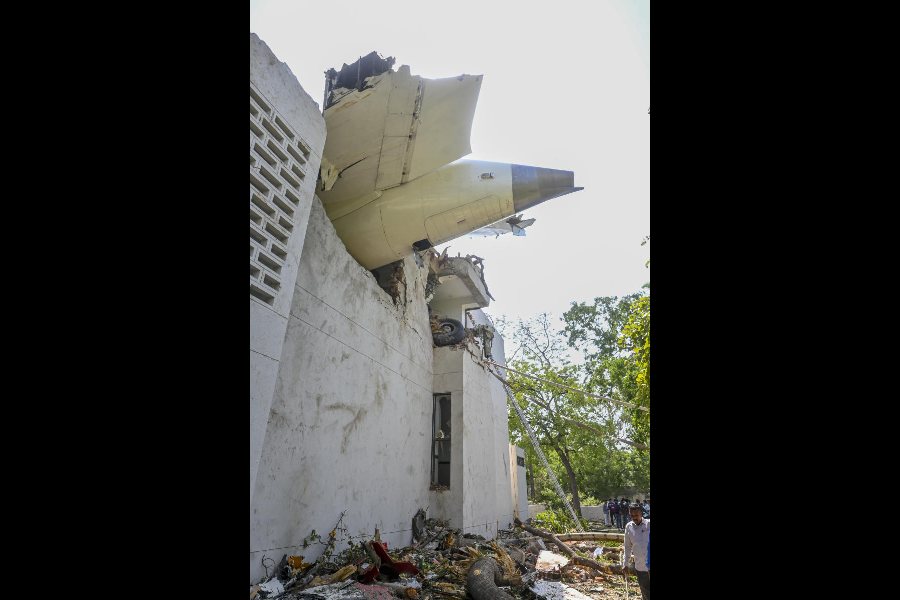|
|
| Look on, and despair |
Every night, at 11 pm, Moumita Pan waits in the dark with her schoolbooks for the electric light to come on. A student of Class XI, she has to race through her studies before the light goes out again at two in the morning. Moumita is the only girl in the workers’ quarters of the Jenson and Nicholson plant at Naihati, closed since 2004, who has cleared the Madhyamik and has not dropped out yet. “When the supply of water and electricity stopped, we pleaded with the authorities and this is what we get: ten minutes of trickling water twice a day and three hours of electricity late at night,” said her father. These, and a derelict two-roomed tenement, are the only things provided by the company where he has worked as an electrician for 22 years. As there has only been a ‘temporary’ suspension of work, not a formal closure or lay-off, the workers are not getting back their dues or other stipulated allowances. Many have left and the staff quarters wear the look of a ghost colony. Others, like the Pans, cling on as hope runs thin and a question gathers urgency: will the factory ever reopen?
At around 3.30 am, when Moumita has gone back to bed, her parents are up and about. Her mother lines up pots and pans before the tap to collect water, while her father prepares for the long trek to Jagaddal, a jute mill cluster 8 km away, in search of casual or thika work. Morning will find the mother-daughter duo plucking nylon threads from used car tyres. Two pairs of nimble hands working for a couple of hours can pluck 10 rupees worth of thread. By then, it is time for the mother to do household chores and the daughter to leave for school.
For nearly 400 workers’ families of the closed paints factory, this is a daily ritual. And yet, this is but a small chapter in the larger story unfolding around here. A stone’s throw away is the Gauripur Jute Mills, locked out since 1997. Set up in 1885, the mill once had its own thermal power generation unit and employed 22,000 people. Beside the jute mill is Containers & Caps Limited, also locked out, that had 900 workers on its payroll. Nearby, Indian Paper & Pulp Ltd, with about a thousand employees, stopped production in 2003. Nuddea Jute Mills, another large mill, suspended work indefinitely since October this year. A few thousand acres of land between the towns of Naihati and Halisahar in the North 24 Parganas, east of the river Hooghly, bear witness to a century-old story of industrialization gone horribly wrong. The economic impact of this on the region is severe; the social and political impact, too, is no less stark. The Shilpanchal Banchao Mancha, a local non-political forum of teachers, social workers and civil rights activists, has come forward to assess the enormity of the problem and organize awareness campaigns.
“You will mistake it for an urban slum unless you know how the place looked like about, say, a decade ago,” said Debashis Pal, a member of the forum. Rows upon rows of dilapidated brick structures of the old mazdoor lines, many of them padlocked or converted into pig pens, made it hard to believe that this had once been a bustling place where life revolved around the periodic bursts of the mills’ sirens. The tall chimney of the jute mill stood defiantly against the sky, while a scraggy banyan atop it told a different story. We walked down a littered-up path, past mounds of scrap iron and fly ash, to a tea-shop across the mill gate. We met Brindavan Prasad there.
Brindavan, a dark gaunt man in his early sixties, was a senior fitter earning Rs 5,000 a month when the jute mill locked out. According to labour laws, the workers of a closed factory are entitled to compensatory allowances. “But by the time the labour department had time to hear us, many of us were more than 58 years old,” said Brindavan. “So they told us that now we were only entitled to retirement benefits.” Many have died since; others are too infirm to eke out a living. They either starve or depend on their children. Brindavan had worked for a security agency in Sector V, until rheumatoid arthritis forced him out of the job. His son works there now. “He is getting more than I did as they prefer young people. You see, the job of a watchman has no use for the skills of a mistri,’ Brindavan said with a sad smile.
The jute mill has been closed for more than a decade now, and yet, the employees have not received a single penny from their provident fund, gratuity and other dues, though a few crores are said to be lying with the trustee board run by political leaders of the ruling dispensation. When I asked about this, everyone at the tea-shop joined in a bitter chorus of how, for the last 11 years, leaders of all major trade unions have led them into a labyrinth of misinformation and false promises. The torn and faded posters with familiar party symbols, pasted on the mill gate a long time ago, added a fitting background to this tale of betrayal.
Brindavan invited us to his quarters in an annexe of the mill compound. Almost paralyzed in one leg, he limped on, holding a bamboo stick. A quick look at the quarters, choked with wild plants and with mounds of beaten tyres lying about, brought on a numbing sense of desolation. Behind it loomed a part of the factory buildings, with fine, though crumbling, neo-Gothic architecture. Rusty swings and see-saws peeped out of thick bramble bushes. “About 400 workers’ families lived here once,” said Brindavan, “now only a few dozen do.” They were part of a larger working class community composed of people from the neighbouring states and even distant ones like Tamil Nadu. They lived in peace and harmony, and followed their different social and religious rites. Brindavan’s wife offered us thekua, home-made pancakes from the recent Chhat Puja offerings, and began to reminisce: “Earlier I used to make 10-20 kgs of these, but those days are past. We celebrated every festival. On hafta (weekly wage payment) days, the mill ground would turn into a huge fairground where people came from across the river too. This looks like a haunted place now, especially during the mornings and evenings, without the mill’s siren and the procession of workers.”
More than the visible signs of decay and desolation, it is the absences that are the most harrowing — the clueless waiting, the slow withering of hope, the silences. Brindavan led us down a path along the factory walls, past community latrines standing amid scummy pools where pigs wallowed, to the riverfront. The ruins of the thermal power plant, which once produced seven mega watts of electricity and served the needs of this industrial zone, can be best viewed from here. Skeletal remains of iron jetties, used to transport raw jute and finished goods down the Hooghly, stood on shallow waters. The local municipality has been using the riverfront as a dumping ground, choking the river that had once been a lifeline for the industries here. A scrap recycling business thrives now, employing children as well as workers of the closed factories. “Wooden frames, iron railings and even machinery are being stolen away from the factories and sold here,” Brindavan said.
We came upon a group of men and women, most of them looking quite old and feeble, sifting dirt dug out of the factory shop floors and picking out bits of iron using magnets from discarded microphone speakers. Brindavan knew many of them: once skilled workmen like him, they now worked here from six in the morning to five in the evening, making 30 rupees a day. We tried to engage them in conversation but they remained cold and silent. They seemed to inhabit a different world.
In any case, what could we have told them? That an industrially resurgent West Bengal is round the corner? That the Centre has recently formed a National Skill Development Mission with a budget of Rs 15,000 crore? They could ill afford such news.












